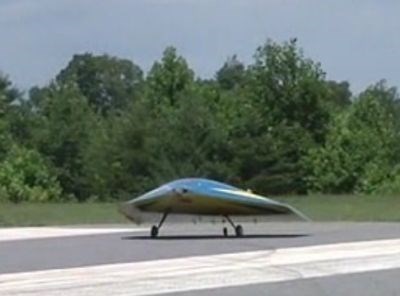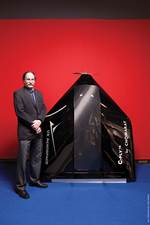VX-1 KittyHawk first flight video
Successful first flight test matches computer predictions and enables virtual testing of next refinements.

The VX-1 KittyHawk 1/4-scale model completes first flight test. SOURCE: VX Aerospace
The VX-1 KittyHawk is a blended wing body aircraft made by VX Aerospace (Morganton, N.C., USA) using C-ply advanced carbon fabrics from Chomarat North America (Anderson, S.C.). The aircraft offers structural efficiency, lightweight and unusually large payload space as an unmanned aerial vehicle (UAV) or cargo space as a sport aircraft. This combination of design and large volume allow the KittyHawk to incorporate compressed natural gas (CNG) as a fuel with no aerodynamic compromise, and thus, the potential to provide new levels of fuel efficiency and emissions reductions.
A ¼ scale model recently completed the aircraft’s first flight test and performed well. “The test flight showed that the plane is dynamically stable and that the control systems work well,” said VX Aerospace Chief Engineer Bob Skillen. “It confirms the aircraft’s potential and we are processing the data to plan our next flight test in late summer.”
Skillen describes the aircraft as “dynamically stable” but in the video below, the airplane model looks very “tippy”. Skillen explains, “"Every motion you see the airplane make in the video is in response to a pilot input. It's the first time this shape has ever been flown. It takes a few moments for the pilot and aircraft to become acquainted. Also, a lot of the maneuvers were intentional for control system/response data."
Lars Soltmann, a Ph.D. student at North Carolina State University (NCSU, Raleigh, N.C., USA) and UAV researcher who performed the computational fluid dynamics (CFD) analysis on the KittyHawk, explained that lifting body designs (blended wing body aircraft) can be a bit “twitchy” because of the lack of damping from a tail. “Also, flying wings generally have a lower pitching moment of inertia because their mass is less spread out vs. traditional aircraft designs,” he adds. “Stability can be increased by shifting the center of gravity forward.” So a bit of modification will take place before the next test flight.
Skillen points out that the team can actually play with a variety of design changes to the aircraft and then test them virtually in the computer. “This is possible because the flight data collected matches perfectly with the CFD and wind tunnel projections generated by Lars.” Soltmann expounds, “Bob gave me a shape and other details, and I put that through CFD computations. Then we 3-D printed a model of the aircraft, with a 1-ft wingspan, and tested that in the wind tunnel. The data matched almost on top of each other.” This confidence in their performance predictions and a now well-established baseline is what will enable the team to refine the VX-1 KittyHawk with virtual testing until they are ready to flight test again.
The test pilot, R.J. Gritter, is also from N.C. State and is a very experienced full-scale aircraft pilot as well as an expert remote control/unmanned aerial vehicle pilot, winning several championships and representing Team USA in the next international radio control aerobatics competition.
The dives mentioned above are called pitch doublets, where RJ pulls back on the stick, holds, pushes forward, holds and then returns back to neutral. “These excite longitudinal aircraft modes that we then compare back to the computer simulations,” explains Soltmann. Again, the test data looks good and the team has a clear idea of what they need to do next.
Related Content
Composite rebar for future infrastructure
GFRP eliminates risk of corrosion and increases durability fourfold for reinforced concrete that meets future demands as traffic, urbanization and extreme weather increase.
Read MoreMaterials & Processes: Composites fibers and resins
Compared to legacy materials like steel, aluminum, iron and titanium, composites are still coming of age, and only just now are being better understood by design and manufacturing engineers. However, composites’ physical properties — combined with unbeatable light weight — make them undeniably attractive.
Read MoreNovel dry tape for liquid molded composites
MTorres seeks to enable next-gen aircraft and open new markets for composites with low-cost, high-permeability tapes and versatile, high-speed production lines.
Read MoreThe state of recycled carbon fiber
As the need for carbon fiber rises, can recycling fill the gap?
Read MoreRead Next
VX Aerospace: Small company, big performance
Innovative design, OOA manufacturing and C-PLY laminate construction produce “big fabricator” aerostructures in fewer steps at low cost.
Read MoreFrom the CW Archives: The tale of the thermoplastic cryotank
In 2006, guest columnist Bob Hartunian related the story of his efforts two decades prior, while at McDonnell Douglas, to develop a thermoplastic composite crytank for hydrogen storage. He learned a lot of lessons.
Read MoreCW’s 2024 Top Shops survey offers new approach to benchmarking
Respondents that complete the survey by April 30, 2024, have the chance to be recognized as an honoree.
Read More





















